MoFi Electronics' MasterPhono™ Combines Versatility And High Sonic Performance
transimpedance and voltage gain inputs, remote controllability and much more
Put yourself in the shoes of an audio designer like industry veteran Peter Madnick. You are tasked with creating a phono preamplifier at a given price point. In the case of the MoFi MasterPhono phono preamplifer, around $6000. That puts it not at the “luxury” level, but well above “entry level.”
Absent price constraints a designer can offer high sonic performance and a generous feature menu, but as the price drops, the higher becomes the tension between features and performance.
Madnick set high design bars for both features and performance and then got down to figuring out how to offer both for $6K For instance, the best way to minimize noise and increase S/N ratios would be to locate the power supply outboard in its own chassis, but a second chassis and an umbilical would add to the final price and perhaps limit other features.
His “workaround” puts two boxes within a single framed structure sufficiently separated from one another and ground-isolated. The power supply and microprocessor control business are upfront, adjacent to the front panel’s buttons and knobs, while the low voltage signal processing circuitry is in the rear, just behind the panel mounted RCA and XLR inputs and outputs. The most sensitive circuitry containing discrete JFET amplification and passive RIAA are separately housed within a temperature sensitive, shielded copper enclosure.
Copper tube conduits, one on each side of the interior frame adjacent to attractive outer wooden side panels (available in both walnut and black finishes) and one in the center, move shielded D.C. back to the main board on one side and on the other A.C. from the rear panel IEC jack to the upfront power supply. The middle tube routes remote control function ribbon cables.
Feature Packed Functionality
You have a choice of three chassis mounted rear panel inputs: a transimpedance MC input for which you can choose either single ended RCA or balanced XLR input (but simultaneously not both), plus a single ended RCA and balanced voltage gain based MM/MC input that’s front panel switchable. In other words, you can simultaneously use both voltage gain inputs and switch between them on the front panel.
Each input “remembers” its settings, including (if applicable) gain, loading, mono/stereo and subsonic filter. A front panel mounted rotary switch sets 40, 50,60 and 70dB gain (nominal, depending upon whether you are using the unit single ended or balanced). A second rotary knob selects loading of 15 0hms, 30, 50, 75, 100, 500,1K Ohms, 10K Ohms, and 47K Ohms + 150pF. There’s also an “options” position that selects the rear-mounted RCA jacks where you can insert your resistive choice loading plugs. This is far more convenient than having to open things up to install resistors into board mounted sockets. Subsonic filter and mono buttons sit between the input and loading knobs. The only missing option is capacitive loading for the MM setting, which is pre-set to a very reasonable 150pF.
Directly above the input knob and adjacent to a pair of large VU type meters is a multi-function “meter” button. A brief press toggles on and off the meter backlight. Simultaneously pressing and turning the input knob adjusts LED and meter backlight brightness.
Pressing and holding the button puts the meters into “mode 1”. Playing the first track on the Analogue Productions Ultimate Analogue Test LP you use the gain knob to adjust the meters to 0dB. Pressing the “meter” button again puts the meters into “mode 2”, which sums the outputs and puts the channels out of phase with one another. If the meters show zero output, your channels are electrically balanced. If there is output you’d adjust azimuth to produce a total “null” between the channels and zero output.
While that produces perfect electrical channel balance it does not guarantee maximum separation as anyone who’s used an oscilloscope to set azimuth can attest. Often one can achieve better L-R, R-L separation numbers with the balance off by .5dB or so. Nonetheless, this is a convenient, easy to use feature that will give users a reasonable approximation of ideal azimuth setting, and sometimes perfect electrical balance does produce maximum separation.
If all that functionality wasn’t enough, there’s also a nicely milled aluminum remote control from which you can select input, gain, loading, subsonic filter, mono, mute and even extinguish the front panel LEDs.

Set Up and Use
Set up was straightforward so no need to go through the obvious, though I did run it both balanced and single-ended “out”. When you first turn on the MasterPhono the front panel runs through the full LED set and lands on whichever input you last used. If you’ve used the transimpedance input all the LEDs surrounding the loading knob are extinguished. The instructions mistakenly say both resistive loading and gain LEDs are extinguished in this mode but not so. The gain LED setting remains lit, and you can adjust. That will be fixed in subsequent manual printings. It’s a minor point, but I wish both front and rear panel illustrations were presented in the manual (only the rear is) and both were more clearly drawn than the current manual’s rear panel illustration.
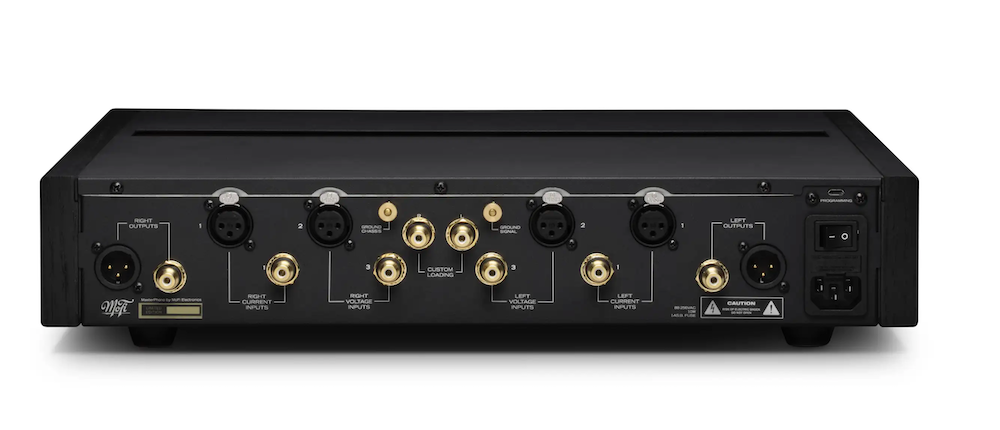
Sound
If you are interested in a phono preamp that imparts to what it’s fed noticeable warmth or enriched textures and detail robbing sweetness, the MasterPhono is not for you. Let’s start there. It strives for timbral neutrality and mostly achieves it, meaning it delivers a cartridge’s essential character—if I had to ascribe a tonal character, I’d say the MasterPhono is ever so slightly on the warm side of neutral. I was able to use it with more than a few cartridges, a few that are under review now, among them the $3995 Analog Relax EX 300 (.5mV output 15 ohm internal impedance) and the $2995 Miyajima Labs Carbon (.23mV output, 16 ohm internal impedance). I also ran the Lyra Atlas Lambda SL, Audio-Technica AT MC2022 and Ortofon Diamond.
The EX300 and Carbon, both wood bodied cartridges, are more similar in personality than they are different, though they do not sound identical. The MasterPhono in either voltage or current mode allowed their well-balanced but “woody” qualities to express themselves, though 15 and 16 ohm internal impedance pushed the limits of effective current mode operation and through the voltage gain input both sounded somewhat fuller, richer and I suspect more like what the designers were trying to achieve.
The ability to easily switch between current and voltage modes is not unique to the MasterPhono but it’s a useful feature offered by only a few phono preamps I know of, especially at or near this price point. When I used the current mode input with the Lyra Atlas Lambda SL with its 1.52 ohm internal impedance and .25mV output, I got to hear the “maxxed out” MasterPhono. I doubt many buyers of the $6000 MasterPhono will use it with a $12,995 cartridge (or a $300,000 OMA K3 turntable, though mine is a far less costly, though equally good sounding prototype) but it was interesting to hear the combo!
I spent a few hours the other day comparing four pressings of Van Morrison’s 1970 release His Band And The Street Choir: an original radio station service white label promo (an RL Sterling Sound mastering), a standard original green label RL pressing, the Tom Biery produced Warner Brothers reissue cut in 2008 by Kevin Gray at AcousTech mastering located at RTI’s pressing plant and finally the brand new Rhino High Fidelity issue cut by Gray at Cohearent Audio. I took notes, with all observations based on the Lyra Atlas Lambda SL into the current mode.
This is an exceptionally fine Elliot Scheiner recording produced at the late Phil Ramone’s A&R Studios that’s only sounded better and better as my system has improved over the past 50 plus years with more and more previously hidden detail exposed and a greater ability to hear into the expertly crafted mix—like the subtle use of variable reverb applied to “I’ll Be Your Lover, Too” and the dramatic acoustic guitar punctuation, the dynamics of which now produce a major “jump” factor but years ago were just “there”.
Right from the opening bars of “Domino”, which begins with a cleanly rendered guitar line and an in the room wood block, you know you are in for a great sonic ride. This is as natural a sounding studio recording and three-dimensional mix as that era produced. The MasterPhono delivered all the mix’s subtle layers and did an especially good job on the high frequency percussive transients. The cymbals on “Call Me Up in Dreamland” particularly impressed with just the right combination of sparkle and transient precision. The backup singers were all easily heard as individuals and not as a mass of voices.
The acoustic guitar on “Crazy Face” is placed well back in the mix but should be easily followed throughout. The MasterPhono managed it well. When Van’s horn enters shrieking on “Crazy Face” it should be well forward of the guitar and the fluttery modulation fast and well-focused but not at all edgy. Percussive acoustic guitar accents should cut through as musical punctuation marks and a tremeloed organ floating behind should percolate in its own juices. The MasterPhono presented all this harmonically fleshed out and spatially well-organized. A hallmark of a great phono preamp (or of any piece of audio electronics) is the ability to see deeply into a great mix and effortlessly sort out the parts without disturbing the cohesion with spotlighting. The MasterPhono did that with ease on this all versions of this album, though the new Gray mastering easily came out on top.
On the doo-wop/New Orleans-ish “Give Me A Kiss” there’s a Fats Domino-like piano part sitting in the background on the left channel that can easily get lost or lose note definition. The MasterPhono did a really good job there too. On “I’ve Been Working” you can almost hear someone pick up a tambourine and then start hitting it. On all of these pressings the exceptionally cleanly recorded tambourine zills were effectively engraved into the grooves but especially on the original and the new Rhino edition. The moderately priced MasterPhono delivered them with impressive transient precision—neither too sharp nor to soft and finely sized well back on the soundstage.
When I was finished, I played selections from the four pressings on the CH Precision P10 also here for review. It costs $77,000. I would have written the same listening notes—which is not to suggest the two phono preamps sounded alike. Trust me they did not but both reliably expressed the relative pressing differences—though one with alarming precision painted on a black velvet backdrop.
Without switching back to the P10 I was perfectly content listening to this record, among many others of course, through the MasterPhono, feeling I was getting the full picture. When Peter Madnick was here delivering and installing it, we did a few back and forth comparisons and while he kept his opinions close to the vest he clearly heard the differences between $77K and $6K but we both were impressed and satisfied by the MasterPhono’s quiet backgrounds, nimble well extended bass performance, upper frequency transient precision, three-dimensional soundstaging, satisfying dynamics and overall timbral neutrality. Producing at this price point a high level of detail resolution and subtle textural authority while avoiding even a hint or glare or grain is difficult to accomplish. The MasterPhono does it. It's an exceptional value considering its features and performance.
After a few months of back and forth listening to both the current and voltage inputs it’s easy to conclude that if the MasterPhono can satisfy on a massive system into which it’s been, you could say, unfairly placed, in the real world context into which it will most likely find a home, it’s likely to please most listeners other than perhaps tube aficionados. While the MasterPhono’s overall timbral balance is on the slightly warm but very pleasing side, it doesn’t have the sonic glow those folks crave. Fair enough. But for everyone else the combination of an unusually full feature set and an impressive level of transparency and sophisticated imaging and staging combined with timbral generosity and transient delicacy should satisfy most listeners.
The MasterPhono and the Shure V15VxMR Caper
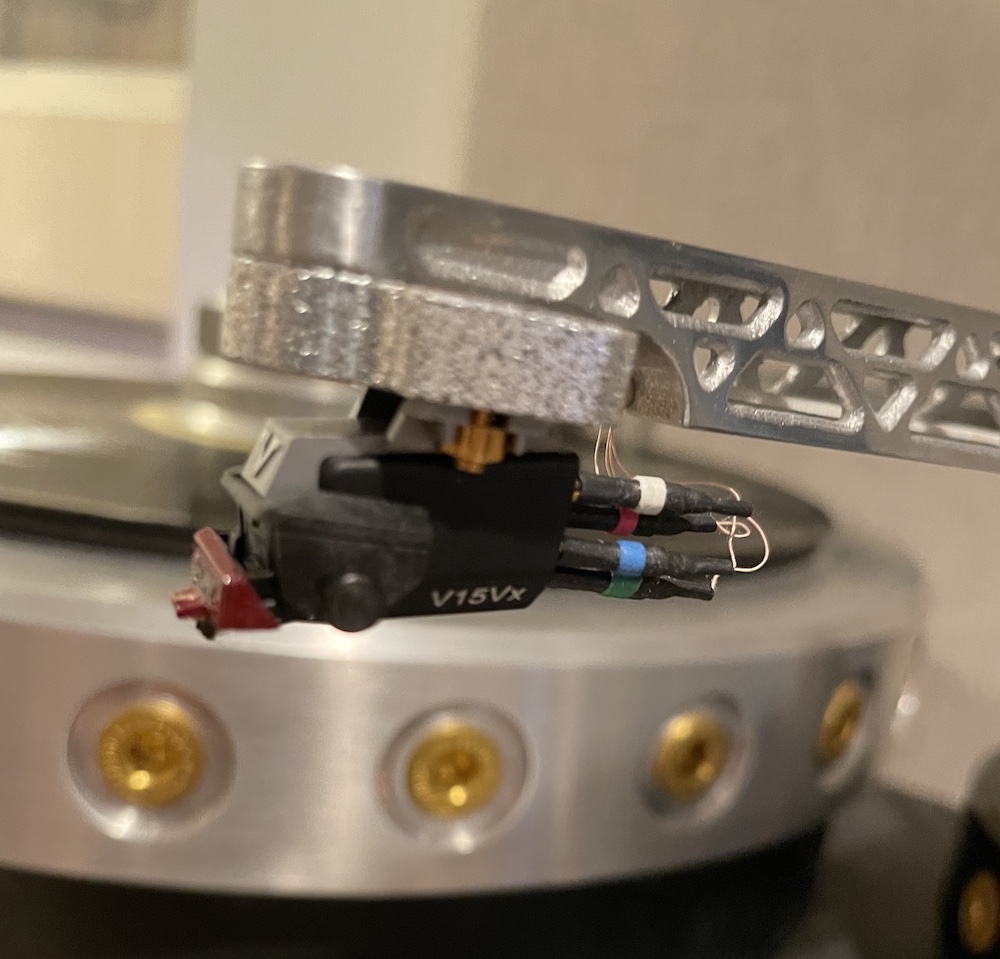 Well into the review, a mini-controversy erupted over the “Original Source” reissue of Emil Gilels’ Brahms Piano Concertos with Eugen Jochum conducting the Berlin Philharmonic (DGG 4864502) a double LP set that the EBS team inscribed fully into the grooves—no compression no limiting, and no bass attenuation to be sure every turntable could handle it. Reviewer Michael Johnson’s Umami Red had trouble tracking parts of it. I played it through the Lyra Atlas Lambda SL on the SAT CF1-12 arm and sent a file to Michael who heard the same issues (they were more problematic for him than for me, (but then he plays in a symphony orchestra) so we decided to give it the Shure V15VxMR ‘trackability test’.
Well into the review, a mini-controversy erupted over the “Original Source” reissue of Emil Gilels’ Brahms Piano Concertos with Eugen Jochum conducting the Berlin Philharmonic (DGG 4864502) a double LP set that the EBS team inscribed fully into the grooves—no compression no limiting, and no bass attenuation to be sure every turntable could handle it. Reviewer Michael Johnson’s Umami Red had trouble tracking parts of it. I played it through the Lyra Atlas Lambda SL on the SAT CF1-12 arm and sent a file to Michael who heard the same issues (they were more problematic for him than for me, (but then he plays in a symphony orchestra) so we decided to give it the Shure V15VxMR ‘trackability test’.
I installed the V15 on the Schröder/OMA “girder arm”, set the tracking force to 1 gram (1.5 actually, the brush lowers it .5g) and played and recorded the most difficult to track parts of side 3, which is cut almost to the label. The Shure did as advertised and tracked it best.
It was also an opportunity to audition the MasterPhono’s MM input and the results demonstrated both what MM advocates about their favorite—of course outstanding tracking, observational flat frequency response (not measured) and a full, rich “meaty” sound that lost MC sparkle and flash but gained undeniable weight and richness.
You’ll be able to hear the V15 and MasterPhono on a Gilels excerpt embedded in Johnson’s review (Not yet, because it was copyright restricted and we are trying to resolve it with DGG). The piano sound has impressive weight and body yet the transients are not softened. The combo paints a pleasing picture that even committed MC advocates will appreciate.
On the His Band and The Streetchoir Van’s vocals and those of the background singers had convincing and honest textures, free of glare. On “Virgo Clowns” there’s a bass clarinet on the right channel and a mandolin on the left. I’m very familiar with it but the weight and texture of this rendering produced from this track a series of new pleasures.
Conclusion
Designer Peter Madnick has designed an uncommonly versatile and fun to use phono preamplifier with a modern, full function, remote controllable feature set. Multiple inputs, voltage and current based MC inputs, a full range of gain and loading adjustments, a subsonic filter and a mono button plus meters there for more than just watching. Made in America build quality is also high and with its wood side cheeks it’s good looking too. The side cheeks are available in both walnut and black finishes:
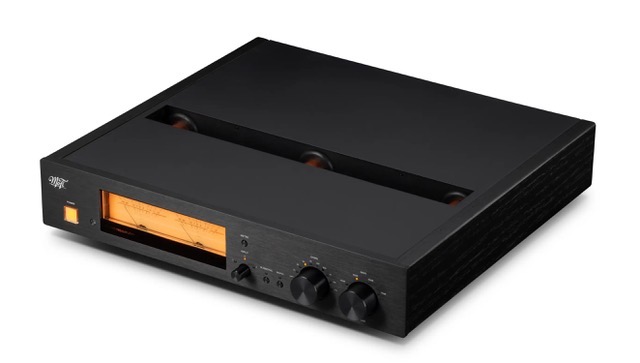 MasterPhono in Black
MasterPhono in Black
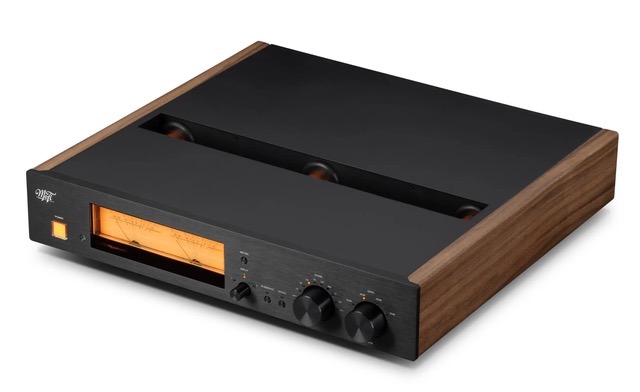 MasterPhono Walnut
MasterPhono Walnut
The MasterPhono’s sonic performance in all modes matches the unit’s attractive looks and versatility. Through all inputs its overall sonic demeanor is on the ever so slightly sweet side, but it never sounded frustratingly soft or warm. Instead, its combination of timbral neutrality, background quiet, deftly delivered transients, pleasing image focus, effective, stable imaging and generous soundstaging and especially its deft balance of all these important phono preamp qualities will let your cartridge’s sonic personality shine.
These days on the Internet some people won’t pay attention unless you scream conclusions like ‘GIANT KILLER!’ ‘YOU WON’T BELIEVE YOUR EARS’, ‘IF THERE’S ANYTHING BETTER I HAVEN’T HEARD IT (AND I’VE HEARD FOUR PHONO PREAMPS IN MY ONE YEAR REVIEWING CAREER)’, ‘A GAME CHANGER!’ or ‘NO NEED TO SPEND MORE, THIS IS AS GOOD AS IT GETS’, but I don’t do that.
You will believe your ears and your ears will tell you this is a well-balanced, honest and “musical” sounding phono preamp that you’ll immediately appreciate and are not likely to get tired of for a very long time if ever. There are better sounding phono preamps, but you’ll have to pay a great deal more to get what makes them so.
I’ll conclude with: The made in America MoFi MasterPhono is among the most versatile, easy and fun to use phono preamp available today and it’s also among the most pleasing sounding for its price and well beyond. Highly recommended. Includes 60 day money back guarantee through Music Direct
Features:
Fully discrete from input to output
Single ended RCA and Balanced XLR output
Switchable Gain 40db/50db/60db/70db
Passive RIAA using NOS polystyrene and polypropylene film/foil capacitors
Standard signal input via RCA & XLR (Voltage Input)
10 position loading adjustment, including "Custom" via RCA plug
"Current input" via RCA or XLR for low source-impedance phono cartridges
Stereo/mono switch, High pass filter switch
Left and Right meters for output monitoring and calibration purposes
Cascaded voltage regulation stages for lowest noise
Dual-chassis construction isolates power supply and audio circuits separately
Software upgradable via USB to add new updates and features
Specifications
Input: Current mode & Voltage mode, balanced and unbalanced
Gain: Selectable gain for MM or MC 40db, 50db, 60db, 70db
THD:
10mV@1KHZ MM low: 0.005% A-Weighted
10mV@1KHZ MM high: 0.005% A-Weighted
1mV@1KHZ MC low: 0.010% A-Weighted
1mV@1KHZ MC high: 0.013% A-Weighted
Loading: 15 Ohms, 30 Ohms, 50 Ohms, 75 Ohms, 100 Ohms, 500 Ohms, 1K Ohms, 10K Ohms, 47K Ohms+150pF, & "Custom"
Output Impedance:
Balanced: 230 Ohm
Unbalanced: 115 Ohms
Max Output: @1% THD, 10 Volts RMS
RIAA Accuracy: +/-0.05db
Frequency Response: 10Hz – 50KHz +/-0.20db
S/N ratio (20Hz-20KHz):
Balanced MM: 85db, 93db
Balanced MC: 81db, 85db
Unbalanced MM: 75db, 83db
Unbalanced MC: 69db, 75db
Dimensions: 17.5" x 3.5" x 15.75"
Weight: 15 lbs.


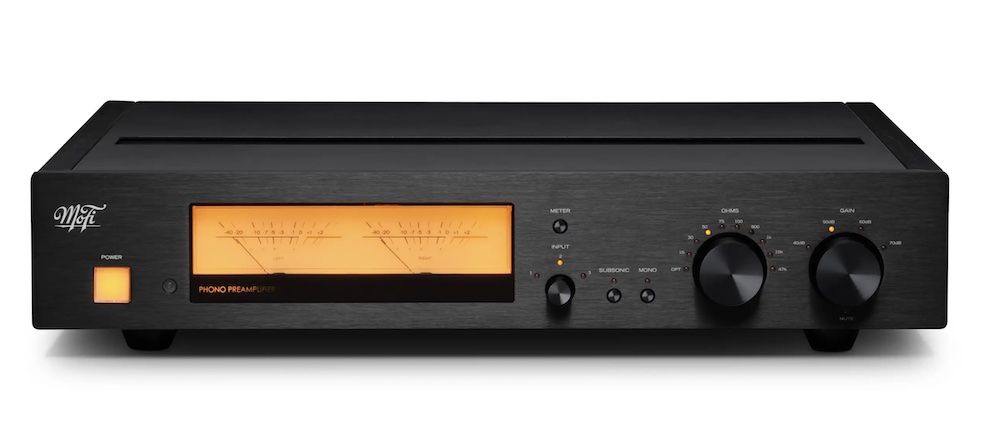






































.png)








